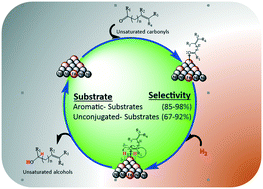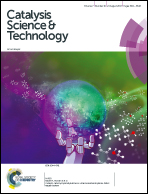Selective hydrogenation of unsaturated carbonyls by Ni–Fe-based alloy catalysts†
Abstract
Ni–Fe alloy catalysts prepared by a simple hydrothermal method and subsequent H2 treatment exhibited the greatest activity and selectivity for the hydrogenation of biomass-derived furfural to furfuryl alcohol among the examined second metals, such as Al, Ga, In, Co, and Ti. This work reveals that the alloying of Ni and Fe is a key factor in achieving highly selective hydrogenation of the C![[double bond, length as m-dash]](https://www.rsc.org/images/entities/char_e001.gif) O moiety in unsaturated carbonyl substrates. We found that decreasing the temperature of H2 treatment (i.e. decreasing the crystallite size), e.g. Ni–Fe(2)HT-573 K (TOF = 952 h−1), increased the activity compared to that over Ni–Fe(2)HT-673 (TOF = 375 h−1) for furfural hydrogenation. This result suggests that a low-coordinated Ni–Fe alloy was imperative for the catalytic cycle. Moreover, the effect of the metal/support interface was critical; despite the high catalytic performance of Ni–Fe/TiO2, Ni–Fe/Al2O3, and Ni–Fe/CeO2, Ni–Fe supported on SiO2, taeniolite, and hydrotalcite catalysts were ineffective. Vibrational studies using FT-IR measurement confirmed that furfural was physically adsorbed on the surface of the Ni–Fe alloy catalyst via an η1(O) configuration. The synthetic scope of the Ni–Fe catalytic system was very broad; various types of unsaturated carbonyls, such as unsaturated aromatics, unconjugated aliphatics, and a large substituent, were selectively converted into the corresponding unsaturated alcohols.
O moiety in unsaturated carbonyl substrates. We found that decreasing the temperature of H2 treatment (i.e. decreasing the crystallite size), e.g. Ni–Fe(2)HT-573 K (TOF = 952 h−1), increased the activity compared to that over Ni–Fe(2)HT-673 (TOF = 375 h−1) for furfural hydrogenation. This result suggests that a low-coordinated Ni–Fe alloy was imperative for the catalytic cycle. Moreover, the effect of the metal/support interface was critical; despite the high catalytic performance of Ni–Fe/TiO2, Ni–Fe/Al2O3, and Ni–Fe/CeO2, Ni–Fe supported on SiO2, taeniolite, and hydrotalcite catalysts were ineffective. Vibrational studies using FT-IR measurement confirmed that furfural was physically adsorbed on the surface of the Ni–Fe alloy catalyst via an η1(O) configuration. The synthetic scope of the Ni–Fe catalytic system was very broad; various types of unsaturated carbonyls, such as unsaturated aromatics, unconjugated aliphatics, and a large substituent, were selectively converted into the corresponding unsaturated alcohols.



 Please wait while we load your content...
Please wait while we load your content...